Copyright ©2007 PopEntertainment.com. All rights reserved.
Posted:
February 21, 2007.
What a break for
first-time feature animation film director Gil Kenan. After Executive
producers Steven Speilberg and Robert Zemeckis saw his live-action/animated
horror-fantasy short, The Lark he was awarded the directing seat for
Monster House – and now is nominated for a Best Animated Feature
Oscar.
The story goes
something like this: three kids DJ (Mitchel Musso), Chowder (Sam Lerner),
and Jenny (Spencer Locke) discover that the house across the street from
DJ's is alive and it eats anything that goes on its property. They try to
convince the babysitter (Maggie Gyllenhaal), the police, and some weirdo
named Skull (Jon Heder) but have to unravel the mystery of the house
themselves. Once in side the house (voiced by Kathleen Turner) rears its
ugly manifestation and they all run for it to a happily resolved
conclusion.
Following Monster
House, Kenan is now developing The City of Ember, adapted from
the Jeanne DuPrau book.
Did you always have an
interest in fantasy?
This film is kind of a
documentary of my life. I grew up moving from city to city, so the idea of
home and place is important to me. I became aware at a really young age that
the places we live play an important role in who we are as people. That's
been percolating in my head for a while, which led into some of the things
that are explored in Monster House.
Beyond that, I've just
been a huge fan of film since my eyes opened. There are millions of key
experiences that shaped who I am; all defined by movies – ironically, many
of them created by my producers. The person I am is an amalgam of where I've
lived and the movies I've seen.
Did that have an
effect...
…And I hate my dad.
No, no, no, [laughs]. We moved to three different continents by the
time I was eight.
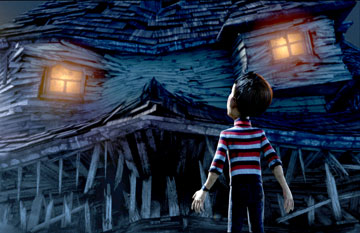 The film is pretty
scary. Isn't it too intense for kids? Who is your target audience?
The film is pretty
scary. Isn't it too intense for kids? Who is your target audience?
Family movies don't
need to be pacifiers. We've dumbed down what we feed to kids in terms of
entertainment these days. There used to be a healthy tradition of kids'
films offering a full range of experiences, from scary to funny to
emotional. You can go back to Snow White and it's got some real
terror, but it's also got the rest which creates a fully rounded story.
I remember Chitty
Chitty Bang Bang, which starts off lightly and pleasantly as a romp and
then takes this sharp turn into the perverse. It always really captured me
on that turn. I always felt that experience made watching the movie more
satisfying. I'm proud this movie doesn't talk down to kids, but appreciates
them for who they are, which is a really brave, smart audience that can
handle a lot more than we give them.
The answer to the
other side of that question was answered for me with the last few screenings
I had been to with family audiences before the film opened. In Pleasantville
the theater was filled with three-to-ten-year-olds. It was wall-to-wall kids
and every single one – their eyes were open the entire time but they were
scared. A four-year-old girl had her hand over her face most of the movie,
but as soon as it was over, her mom asked her, and she said "I loved it!"
She came up to me and thanked me for it. I feel like being scared is not a
bad thing; it's part of being entertained. I have every confidence that this
movie plays to a family audience.
Why did you or the
studio have a Halloween film come out during the summer?
Kids are in school at
Halloween. Once inside the house and leading up to the third act, it's very
much a summer film so it shouldn't have to be squeezed into a one-weekend
Halloween release. There is a tradition of films based on a holiday not
coming out around the holiday but ET was a June release.
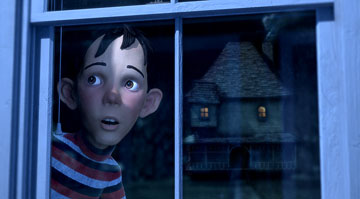 Were you worried that
you'd get crucified for making fun of fatties?
Were you worried that
you'd get crucified for making fun of fatties?
I think she's a tragic
character more than a villainous character. You see in the role of Chowder
that fat's heroic in equal measure. Speaking as a former fat kid myself, and
for a few years, as a fat adult, I can say with some certainty none of it is
against the weight, it's more a character trait of who Constance is.
There's no
motion-capture for the house?
I had Kathleen Turner
on set performing for every instance she and Neb were interacting. She would
be there to perform with him. In every way she is the soul, the spirit of
the house, the embodiment of it. I thought it was necessary to have a real
performance to capture that.
Kathleen Turner is one
of the most giving, generous actors I've had the pleasure of working with. I
asked her about building the neighborhood out of foam and motion-capturing
her going through the house's rampage. She agreed and we built the entire
city in foam and that's going to be an awesome DVD extra. It's pretty
amazing to watch. Although the ultimate performance of the house is mostly
animated, her kind of inspiration is there in every nuance.
How did you pick the
other actors?
At the first meeting,
Robert Zemeckis had a list of names. I was naïve – but it did end up working
that way. I told Zemeckis no one except Steve Buscemi could be Neb.
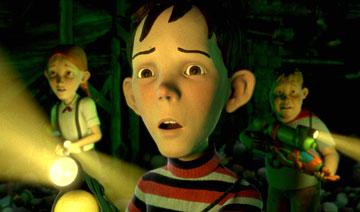 It's uncanny how
individual traits come through even though someone is animated. You couldn't
miss Jon Heder.
It's uncanny how
individual traits come through even though someone is animated. You couldn't
miss Jon Heder.
It's fascinating what
it takes to distill a performance – to communicate who they are. It's almost
like cutting off an arm and it living on beyond its connection to the body.
Even without the facial information, just take an actor's movement, the way
they stand and listen, so much of that humanity is transferred. That's what
fascinated me about using motion capture to extract these performances. I
was able to learn what a human performance was made up of, mathematically,
which was fascinating.
That's an amazing shot
when ambulance pulls away.
I shot that scene as
if I were shooting a live-action film, with some allowance for reduced laws
of gravity. I knew I could do some things that would be impossible in the
real world. It's very important when you're shooting a film virtually to
respect all the laws of narrative filmmaking. I think that's been a weakness
in CG films. Generally the camera is allowed to do these flights of fancy
that have no bearing to gravity, the camera has no weight. When the camera
doesn't have weight, it chips away at the emotional weight of the shot.
I had a hat of reality
on, but I'm glad you like that shot because that's one of those times when I
kind of peeled away the fabric of reality a little bit and that's something
that wouldn't have been possible in live action.
Part of the way I
assembled my crew was picking people who hadn't done CG work before. [I
picked] DP Xavier Pérez Grobet because he shot Before Night Falls,
one of most beautifully shot films in the last 15 years, because it's real
emotional filmmaking, not technical. I knew the technical side would be in
place because of the machine it takes to make a film like this. Every place
I could chip away at the CG ness of what I was doing I would take advantage
of that.
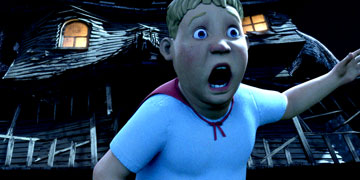 But you're shooting
them on a motion-capture stage.
But you're shooting
them on a motion-capture stage.
The process here is
slightly dissected. The mo-cap shoot is purely about performance. His job on
the mo-cap stage was strictly to capture performances – to have coverage on
actors without any sense of my camera placement in the cinema phase of this
film.
Once all the shooting
was done we moved into our post production offices where Xavier and I and
four camera operators at computer terminals had a virtual reproduction of
every set and every actor's performance I selected from the shoot. We began
to place virtual cameras in those sets, so all the cinema happened after the
actors had gone home.
What do you think sold
these producers on you? Your career had been up to that time...
Non-existent? My film
got me into that meeting, but I knew going into that room it was my one
shot, one chance to sell them. I was the right man to make this movie.
Partly that was done in spite of myself. When I read the script I started
going into convulsions. I was kind of panicked by the amount of imagery and
ideas it forced into my head, so I stayed up and drew a bunch of pictures I
brought with me and ideas I jotted down. In the meeting it was more me, more
spilling forth all the things that had attacked me.
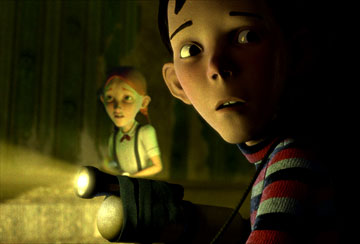 Are you always
thinking about making films?
Are you always
thinking about making films?
I always watched films
– I never had video camera. I expressed myself through drawing, storybooks,
wrote stories. I ended up in theater in high school. I thought I was going
to be a theater director. Then the Northridge earthquake happened the night
before my first directed play in my senior year, and the auditorium was
eaten up by the earth. That was the end of my theater career and I went into
film.
What are your plans
for The
City of Ember?
[To explore] the
further idea of relationship between humans and their environs, but instead
of a house it's a city. It's based on a novel about the last city with light
on it after all lights have gone off in world.
What insights will you
carry from
Monster House to The City of Ember?
I'm still working it
out in the movie. We'll have to ask that in a couple of movies. Obviously a
sense of place is really important to me. There really is such a strong bond
with every house that I've lived in. When I have dreams at night they
usually take place in my childhood home in a Nightmare on Elm St.
kind of way. There's just something I'm figuring out.
Email
us Let us know what you
think.
Features
Return to the features page.
